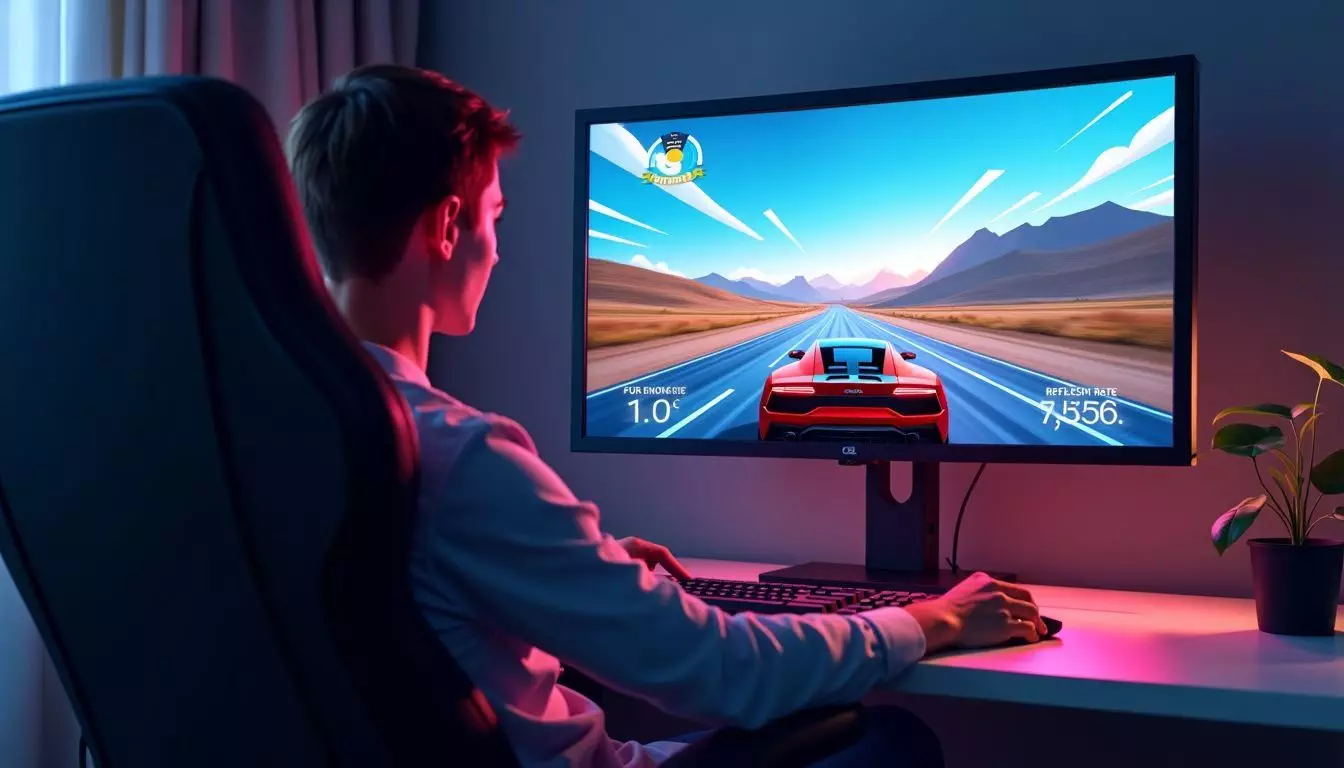Choosing the right gaming monitor involves understanding the key differences between refresh rate vs resolution. Many gamers face confusion when deciding whether to prioritize a higher refresh rate or a higher resolution for an optimal gaming experience.
Refresh rates and resolutions play distinct roles in performance and visual quality, affecting everything from motion smoothness to image clarity. 1
Alex Herrick, with extensive background in web design and interface optimization, understands these technical nuances well. He shares insights on how each feature impacts gameplay quality.
Keep reading to find out which spec should be your top priority!
Key Takeaways
- High refresh rates (like 120Hz or more) reduce motion blur and screen tearing. They give a smoother gaming experience.
- Higher resolutions (such as 1440p and 4K) offer sharper images but need strong GPUs to avoid lag.
- Balancing these specs is key. Casual gamers might be fine with 1080p at 60Hz, while competitive players benefit from higher refresh rates.
- Use Adaptive Sync technologies like G-Sync or FreeSync to match GPU output to the monitor’s rate, reducing screen tearing.
- For optimal performance, consider your CPU power, monitor size, and response time when choosing a gaming monitor.
Understanding Refresh Rate

Refresh rate is key for smooth gameplay. It tells you how many times per second your screen updates.
Importance for Gaming Smoothness
A high refresh rate, like 144Hz, leads to smoother gaming. The screen updates 144 times per second. Faster updates mean less motion blur and screen tearing. 2
Lower rates, such as 60Hz, can cause noticeable lag. Gamers will see a difference in fast-paced games where quick reactions are key. Competitive players often choose monitors with at least 120Hz or 240Hz for the best experience without distractions. 1Impact on Motion Blur and Screen Tearing
High refresh rates reduce motion blur compared to lower ones. This makes fast-action games look smooth and sharp. Monitors with 120Hz or higher refresh the image multiple times per second, minimizing blurring. 4
Screen tearing happens if refresh rates can’t keep up with processed data. Adaptive Sync technology helps fix this issue by matching GPU output to monitor’s rate display. “Monitors with faster response times (e.g., 1ms) cut down on trails and motion blur,” says a tech expert. 3
Adaptive Sync ensures smoother images without splits or tears. For competitive gaming, high-refresh-rate monitors like 144 Hz are a must for optimal performance.
High refresh rates bring gaming visuals to life.
Exploring Resolution
Resolution is all about how clear and detailed an image looks on your screen. Higher resolutions mean you see more pixels, which make the picture sharper.
Role in Image Clarity and Detail
Higher resolutions mean clearer visuals. Professionals in graphic design and video editing need high-resolution monitors. A 4K resolution screen, showing more pixels per inch, improves image quality. 5
Each pixel counts for sharper images and finer details. Common resolutions are HD (1920×1080), QHD, and 4K UHD. Trade-offs exist with higher resolutions; they need powerful GPUs to run smoothly. 6
Trade-offs with Higher Resolutions
Higher resolutions like 1440p and 4K offer stunning visuals. They show more pixels on the screen, making games look sharp and detailed. But high resolution needs a powerful graphics card.
Without it, you might see lower frame rates or input lag. 7
Also, balancing graphics settings is crucial. Gamers can improve reaction times by tweaking these settings. For example, lowering shadows or textures can help maintain smooth gameplay even at higher resolutions. 2
Gamers report improved reaction times and accuracy at higher resolutions.
High resolution also impacts hardware costs. A gaming PC with enough power for 4K gaming could be pricey. Consider if better image clarity is worth the extra cost when buying a monitor.
The Importance of Hertz in Gaming Monitors
Hertz (Hz) measures the refresh rate of a monitor. A display with a higher refresh rate, like 120 Hz or more, reduces motion blur and screen tearing. 4 Gamers prioritize refresh rates because smooth gameplay improves reaction times. 2
High-refresh-rate monitors also enhance game visuals. Games you’re playing look clearer and sharper at 120 Hz compared to standard 60 Hz displays. This is especially true for fast-paced games that require quick movements.
Competitive gamers benefit the most from high-refresh-rate monitors. Their response time improves, giving them an edge in intense matches.
Making the Right Choice for Your Gaming Needs
You need to balance refresh rate and resolution. The best monitor might not be the most expensive one.
Balancing Refresh Rate and Resolution for Optimal Performance
Balancing refresh rate and resolution is crucial for gamers. The right mix can enhance the gaming experience.
- Understand Your Gaming Needs
- Casual gamers are fine with 1080p at 60 Hz.
- Competitive players benefit from 144 Hz and 1080p. 2
- Professional gamers require 240 Hz for smooth motion.
- Consider GPU and CPU Power
- High resolutions like 4K need strong GPUs like Nvidia GeForce RTX 3060. 8
- Fast CPUs like Intel Core i5-11600K handle higher refresh rates well.
- Monitor Size Matters
- Larger screens (27 inches or more) benefit from higher resolutions.
- Smaller screens (24 inches) are ideal for higher refresh rates.
- Pixel Density
- Higher PPI (pixels per inch) offers better image clarity.
- Aim for at least 95-110 PPI for casual use.
- Competitive gaming thrives on 110-140 PPI; professionals go above 140 PPI.
- Test Different Settings
- Find the best balance by testing different monitor settings.
- Adjust in-game settings to match your display’s capability.
- Check Connectivity Options
- Ensure your monitor supports HDMI or DisplayPort for optimal performance. 8
- USB-C is useful for modern setups, especially laptops.
- Budget Wisely
- Invest in a good balance rather than the highest spec available.
- Save money by not overspending on unnecessary features.
- Opt For Adaptive Sync Technologies
– Use monitors with G-Sync or FreeSync to reduce screen tearing.
– These technologies improve gaming performance on compatible GPUs.
- Monitor Response Time
- Choose monitors with low response time, around 1 ms, for rapid gaming action.
- Higher response times can cause blurring during fast scenes.
These steps help achieve optimal performance by balancing refresh rate and resolution effectively for any gaming setup.
Conclusion
Choosing between refresh rates and resolution for gaming monitors can be tough. For the best experience, players must balance both aspects. Higher refresh rates make games smoother.
High resolution makes images clearer. Find what fits your gaming style and tech setup to enjoy the sharpest, smoothest gameplay possible!
FAQs
1. What is the difference between refresh rate and resolution for gaming monitors?
efresh rate is the frequency at which the pixels on a display are refreshed, measured in hertz (Hz). Screen resolution is the number of pixels displayed on the monitor.
2. Why is refresh rate important for gaming?
A higher refresh rate means smoother motion and reduced lag, which can be crucial in competitive games. High-refresh-rate displays like 144Hz or more provide a better experience than standard 60Hz monitors.
3. How does screen resolution affect gaming performance?
Screen resolution impacts image clarity by determining how detailed visuals appear on your monitor. Higher resolutions mean more pixels, leading to sharper images but may require a powerful graphics processing unit (GPU).
4. Should I prioritize refresh rate or resolution when choosing a monitor for gaming?
It depends on your goal—if you play fast-paced games, a high refresh rate is far more important for smooth gameplay. For visually rich games or video editing, go for higher resolution.
5. Can my computer handle both high refresh rates and resolutions?
You need a PC with strong specs to match the monitor’s demands—especially if aiming for both high frame rates and super-high-resolution displays.
6. Are there specific types of monitors best suited for different kinds of games?
Yes! Competitive gamers benefit from high-refresh-rate monitors like 144Hz; while those who enjoy immersive experiences might prefer large-screen options with higher display resolutions.
References
- ^ https://www.intel.com/content/www/us/en/gaming/resources/highest-refresh-rate-gaming.html
- ^ https://www.microsoft.com/en-us/windows/learning-center/best-refresh-rate-for-gaming (2023-04-25)
- ^ https://forums.blurbusters.com/viewtopic.php?t=12565 (2023-10-17)
- ^ https://riverdi.com/blog/monitor-resolution-chart-a-handy-guide-for-the-best-visual-experience?srsltid=AfmBOorHoH2hK2ZcDNGBbK5ToHahoytVCNsHJ2BEioqINcJ5MPo8RM84
- ^ https://medium.com/@chinaseoer1/the-difference-between-refresh-frequency-and-resolution-of-led-display-9cde86238737
- ^ https://www.researchgate.net/publication/228822059_The_effects_of_resolution_on_users_playing_First_Person_Shooter_games
- ^ https://www.91mobiles.com/hub/high-refresh-rate-screen-vs-higher-resolution-for-gaming/ (2024-01-17)

